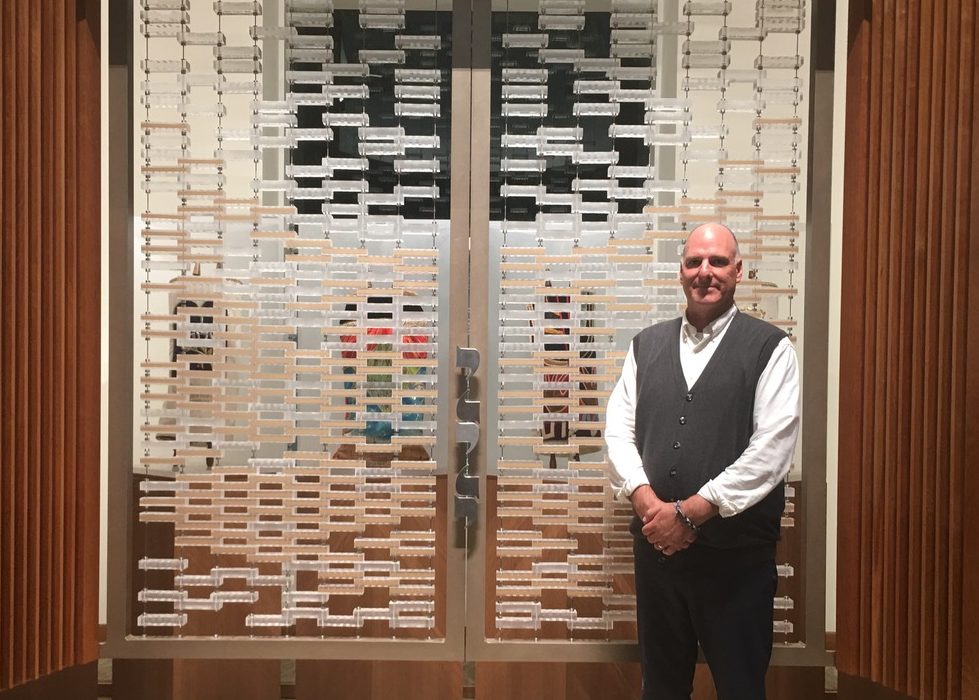 Architect Steve Rajninger. Photos by Ryan Torok
Architect Steve Rajninger. Photos by Ryan Torok
Steven Rajninger, a principal at San Francisco-based Herman Coliver Locus Architecture, specializes in designing sacred spaces and affordable housing. The firm’s designs include the recently renovated Ganzberg Sanctuary at Temple Beth Am.
Rajninger spoke with the Journal about architecture, becoming an honorary Beth Am member and his mission-driven work of designing synagogues and supportive housing.
Jewish Journal: How did the Temple Beth Am project come about?
Steven Rajninger: We were invited to compete for it with other architects, as is typically the case, and to do that architects typically do some measure of conceptual thinking in advance of being awarded the project: How is an auditorium different from a sanctuary, or how is a sanctuary different from an auditorium?
They were longing for this question to be answered and we wrote a responsive reading on the contrast between auditorium and sanctuary: Things like, an auditorium is a black box and a sanctuary is a light box. An auditorium is meant to be a world in and of itself and a sanctuary is meant to explain the world.
These projects take time. You have to be patient, and it’s a good thing because it provides an opportunity for us as architects to get to know the community. You get to have lots of conversations and it always starts really by listening.
JJ: Are you Jewish?
SR: Yes, very.
JJ: Does that help when designing a synagogue?
SR: Absolutely it does. It’s why I love it so much. I think there is so much about the work [that is] so connected to who I am — my roots, my family and the history of the people — that it does feel like the work is flowing through generations. That’s a nice feeling.
JJ: Your work also appears to embrace the Jewish concept of tikkun olam – repairing the world.
SR: [Our] work is completely mission-driven. We only do two kinds of work: sacred space [architecture], which is almost entirely in the Jewish community, and that’s about 40% of our work. The other 60% is supportive housing for very low-income people: families, seniors, people who are formerly homeless. One hundred percent of our clients are nonprofit organizations. That’s a very intentional choice we made in our practice — to be architects for the people and for the work to be mission-driven.
JJ: Why did you decide to work exclusively with nonprofits?
SR: It’s just the ability to work alongside people of like mind. As an architect, you can work for people who are just thinking about the bottom line; you can work for people who are interested in branding; and, of course, there are many ways you can do good. Our passion is to do what’s right and what’s good and to work with people and to help people who are less fortunate and challenged by a variety of things.
Whether you are building housing for people who are less fortunate, or you are building sacred space, you are building space that hopefully lifts people up and elevates their well-being.
JJ: Do you design spaces around the country or only in California?
SR: The jobs are all over California. California has a real crisis in housing. There’s a need. I was waiting until my kids went off to college before I went on planes around the country and spent days away from home, but I’d like to expand our work beyond California.
JJ: Did you always know you wanted to be an architect?
SR: I didn’t discover architecture until I was an undergrad at [UC] Berkeley. I always loved to draw. As a young Jewish boy, I thought I had two choices: doctor or lawyer, and I had no intention of ever being a lawyer. A doctor, maybe. I contemplated being a veterinarian, maybe because I loved animals, but as I grew up that didn’t seem to be the right fit. I took an architecture class at Berkeley, and the first class was almost completely a drawing class. They just touched on architecture at the end.
It was a class that made you think about space, three dimensions, about volume, light and shadow. It was a way to teach you how to see and was, I thought, fascinating, and it was called, Architecture 11A, and I thought if this has the word “architecture” in it, this is good, and I fell in love with it, and after taking that first class, I couldn’t imagine doing anything else in life but what I am doing.
JJ: Will you continue to be involved with the Beth Am community even though you are finished with the project?
SR: It’s interesting. Many times when we are finishing a project like this, the people who led the process come up to us and say, “You know us better than we know ourselves.” It’s really humbling for someone to hear that — and oftentimes they’ll tell us, “You are an honorary member of the congregation,” and we sort of feel that way, too.























 More news and opinions than at a Shabbat dinner, right in your inbox.
More news and opinions than at a Shabbat dinner, right in your inbox.